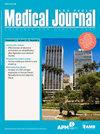癫痫患者亲属抑郁、焦虑症状与白质变化的相关性
IF 1.3
4区 医学
Q2 MEDICINE, GENERAL & INTERNAL
引用次数: 0
摘要
背景:抑郁和焦虑是癫痫患者及其亲属常见的症状。目的:探讨TLE患者亲属白质(WM)变化与精神症状的关系。方法:应用贝克抑郁量表(BDI)和贝克焦虑量表(BAI)对40例TLE亲属的DTI脑MRI进行分析。我们提取了6个WM束(穹窿、扣带、钩侧束(UF)、额枕下束、胼胝体、皮质脊髓束),并分析了分数各向异性(FA)、介质弥散性(MD)、轴向弥散性(AD)和径向弥散性(RD)。我们调查了分数和DTI测量之间的相关性。抑郁症状在10分以上为阳性,焦虑症状在11分以上为阳性。结果:我们观察到37.5%的抑郁症状和27.5%的焦虑症状的患病率。BDI与左扣带FA相关(p=0.0003;r=-0.547);右扣带MD (p=0.015;r=0.401)、左右UF (p=0.023;r=0.374和p=0.021;r=0.363)。BDI与左右扣带RD也有相关性(p=0.0003, r=0.583, p=0.015, r=0.401)。BAI与穹窿FA (p=0.026, r=- 0.352)、左扣带MD (p=0.01, r=0.415)、左侧UF (p=0.003, r=0.374)、左扣带RD (p=0.022, r=0.371)、左侧UF (p=0.01, r=0.440)相关。讨论:此处与精神症状相关的区域与癫痫患者重叠,但与孤立性抑郁症患者主要受影响的区域不同。我们假设一个可能的遗传底物涉及癫痫和抑郁症之间的共病,不同于精神疾病的人没有癫痫。本文章由计算机程序翻译,如有差异,请以英文原文为准。
Correlation between depressive and anxious symptoms and white matter changes in relatives of people with epilepsy
Background: depression and anxiety are common symptoms observed in people with epilepsy and their relatives. Objective: Investigate associations between white matter (WM) changes and psychiatric symptoms in relatives of TLE patients. Methods: We analyzed brain MRI with DTI from 40 TLE relatives and applied the Beck Depression Inventory (BDI) and Beck Anxiety Inventory (BAI). We extracted 6 WM tracts (fornix, cingulum, uncinate fasciculus (UF), inferior fronto-occipital fasciculus, corpus callosum, corticospinal tract) and analyzed fractional anisotropy (FA), medium diffusivity (MD), axial diffusivity (AD) and radial diffusivity (RD). We investigated correlations between scores and the DTI measures. Symptoms of depression were positive with BDI scores above 10, while symptoms of anxiety were positive with BAI scores above 11. Results: we observed a prevalence of 37.5% of depressive symptoms and 27.5% of anxious symptoms. BDI correlated with FA in the left cingulum (p=0.0003;r=-0.547); and with MD in the right cingulum (p=0.015;r=0.401) and right and left UF (p=0.023;r=0.374 and p=0.021;r=0.363). BDI correlated also with RD in the left and right cingulum (p=0.0003;r=0.583 and p=0.015;r=0.401). BAI correlated with fornix`s FA (p=0.026;r=- 0.352), and with MD in the left cingulum (p=0.01;r=0.415) and left UF (p=0.003;r=0.374) and with RD in the left cingulum (p=0.022;r=0.371) and left UF (p=0.01;r=0.440). Discussion: The regions correlated with psychiatric symptoms here overlap with those affected in patients with epilepsy, however, they differ from areas mainly affected in patients with isolated depression. We hypothesize a possible genetic substrate involved in comorbidity between epilepsy and depression, distinct from psychiatric disease in people without epilepsy.
求助全文
通过发布文献求助,成功后即可免费获取论文全文。
去求助
来源期刊

Sao Paulo Medical Journal
医学-医学:内科
CiteScore
2.20
自引率
7.10%
发文量
210
审稿时长
6-12 weeks
期刊介绍:
Published bimonthly by the Associação Paulista de Medicina, the journal accepts articles in the fields of clinical health science (internal medicine, gynecology and obstetrics, mental health, surgery, pediatrics and public health). Articles will be accepted in the form of original articles (clinical trials, cohort, case-control, prevalence, incidence, accuracy and cost-effectiveness studies and systematic reviews with or without meta-analysis), narrative reviews of the literature, case reports, short communications and letters to the editor. Papers with a commercial objective will not be accepted.
 求助内容:
求助内容: 应助结果提醒方式:
应助结果提醒方式:


